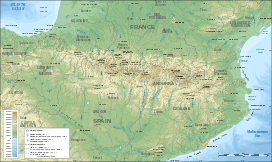Canigou
| Canigou | |
|---|---|
 Canigó, December 2004 | |
| Elevation | 2,784 m (9,134 ft) |
| Prominence | 550 m (1,800 ft) |
| Location | |
 Canigou | |
| Range | Pyrenees |
| Coordinates | 42°31′08″N 02°27′24″E / 42.51889°N 2.45667°ECoordinates: 42°31′08″N 02°27′24″E / 42.51889°N 2.45667°E |
| Climbing | |
| First ascent | According to tradition, in 1285 by Peter III of Aragon |
| Easiest route | hike |
The Canigou (French pronunciation: [kaniɡu]; Catalan: Canigó [kəniˈɣo], locally: [kəniˈɣu]; el. 2,784.66 m./9137 ft.) is a mountain located in the Pyrenees of southern France.
Due to its sharp flanks and its dramatic location close to the coast, until the 18th century the Canigou was believed to be the highest mountain in the Pyrenees.[1]
Trekking and sightseeing
Spectacular jeep tracks on the north side of the massif lead to the Chalet de Cortalets (at 2150 m.) which is a popular outpost for walkers.
There are two ancient monasteries at the foot of the mountain, Martin-du-Canigou and Saint-Michel-de-Cuxa.
Canigou Flame
This mountain has symbolical significance for Catalan people. On its summit there is a cross that is often decorated with the Catalan flag.[2] Every year on 23 June, the night before St. John's day (nit de Sant Joan), there is a ceremony called Flama del Canigó (Canigou Flame), where a fire is lit at the mountaintop. People keep a vigil during the night and take torches lit on that fire in a spectacular torch relay to light bonfires somewhere else.[3] Some estimates conclude that about 30,000 bonfires are lit in this way all over Catalonia on that night.[4]
Literature
The Canigou inspired a collection of poems called "Canigó" by Catalan poet Jacint Verdaguer i Santaló. In these verses Verdaguer compares the snowy mountain to a Magnolia flower:
- Lo Canigó és una magnòlia immensa
- que en un rebrot del Pirineu se bada;
- per abelles té fades que la volten,
- per papallons los cisnes i les àligues.
- Formen son càlzer escarides serres
- que plateja l’hivern i l’estiu daura,
- grandiós beire on beu olors l’estrella,
- los aires rellentor, los núvols aigua.
- Les boscúries de pins són sos bardissos,
- los Estanyols ses gotes de rosada,
- i és son pistil aqueix palau aurífic,
- somni d’aloja que del cel davalla. (p. 27-28)
Meaning: The Canigó is an immense magnolia
- that blooms in an offshoot of the Pyrenees;
- its bees are the fairies that surround it,
- and its butterflies the swans and the eagles.
- Its cup are jagged mountain chains,
- colored in silver by the winter and in gold by the summer,
- huge cup where the star drinks fragrances, the airs freshness and the clouds water.
- The pine forests are its hedges and the ponds its dew drops,
- and its pistil is that golden palace,
- seen by the nymph in her dreams descending from heaven.

See also
- Prieuré de Serrabone
- St-Martin-du-Canigou monastery.
- Vernet-les-Bains
Notes
References
External links
| Wikimedia Commons has media related to Canigou. |
- One of the best mountain marathon races in Europe - to the summit of Canigou and back from Vernet-les-Bains
- Pyrenees Rescue
- Canigo.cat All information about the Canigou massif: nature, culture and itineraries (in Catalan)